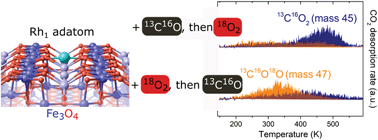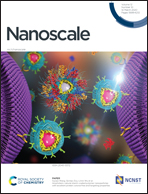Adsorbate-induced structural evolution changes the mechanism of CO oxidation on a Rh/Fe3O4(001) model catalyst†
Abstract
The structure of a catalyst often changes in reactive environments, and following the structural evolution is crucial for the identification of the catalyst's active phase and reaction mechanism. Here we present an atomic-scale study of CO oxidation on a model Rh/Fe3O4(001) “single-atom” catalyst, which has a very different evolution depending on which of the two reactants, O2 or CO, is adsorbed first. Using temperature-programmed desorption (TPD) combined with scanning tunneling microscopy (STM) and X-ray photoelectron spectroscopy (XPS), we show that O2 destabilizes Rh atoms, leading to the formation of RhxOy clusters; these catalyze CO oxidation via a Langmuir–Hinshelwood mechanism at temperatures as low as 200 K. If CO adsorbs first, the system is poisoned for direct interaction with O2, and CO oxidation is dominated by a Mars-van-Krevelen pathway at 480 K.



 Please wait while we load your content...
Please wait while we load your content...